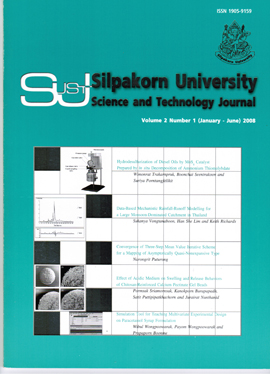Effect of Acidic Medium on Swelling and Release Behaviors of Chitosan-Reinforced Calcium Pectinate Gel Beads
Main Article Content
Abstract
Chitosan-reinforced calcium pectinate (ChCP) gel beads were prepared by ionotropic gelation method. Theswelling of ChCP gel beads and release behavior of indomethacin from the beads were investigated and comparedwith conventional calcium pectinate (CP) gel beads. The factors, such as molecular weight of chitosan,concentration of chitosan, and release medium, which can have a significant effect on the swelling and releasebehaviors from the beads, were discussed in this study. The mechanical test showed that the ChCP beads haveslightly higher strength than that of CP beads. The swelling index of the ChCP beads in acidic medium was muchlower than that in neutral medium. The release of indomethacin from ChCP beads under conditions mimickingintestinal transit were evaluated in pH 7.4 Tris buffer. The acid pretreatment caused a faster drug release fromChCP beads. The less swelling in acidic medium and faster drug release of acid-pretreated ChCP beads may bedue to the dissolution of chitosan from the beads in acidic medium, as no fluorescence signal was seen at the shellof the beads. The results suggested that the acid, which essentially found in stomach, influenced the swelling andrelease behaviors of ChCP beads.
Downloads
Article Details
References
Braccini, I. and Pérez, S. (2001). Molecular basis of Ca2+-induced gelation in alginates and pectins: the egg-box model revisited. Biomacromolecules, 2(4): 1089-1096.
Chang, K. L. B. and Lin, J. (2000). Swelling behavior and the release of protein from chitosan-pectin composite particles. Carbohydrate Polymers, 43: 163-169.
Colombo, P., Bettini, R., Peracchia, M. T., and Santi, P. (1996). Controlled release dosage forms: from ground to space. European Journal of Drug Metabolism and Pharmacokinetics, 21(2): 87-91.
El-Gibaly, I. (2002). Oral delayed-release system based on Zn-pectinate gel (ZPG) microparticles as an alternative carrier to calcium pectinate beads for colonic drug delivery. International Journal of Pharmaceutics, 232(1-2): 199-211.
Hiorth, M., Kjoniksen, A. L., Khudsen, K. D., Sande, S. A., and Nystrom, B. (2005). Structural and dynamical properties of aqueous mixtures of pectin and chitosan. European Polymer, 41: 1718-1728.
Kim, T. H., Park, Y. H., Kim, K. J., and Cho, C. S. (2003). Release of albumin from chitosan-coated pectin beads in vitro. International Journal of Pharmaceutics, 250: 371-383.
Marudova, M., MacDougall, A. J., and Ring, S. G. (2004). Pectin-chitosan interactions and gel formation. Carbohydrate Research, 339: 1933-1939.
Murata, Y., Maeda, T., Miyamoto, E., and Kawashima, S. (1993). Preparation of chitosan-reinforced alginate gel beads - effects of chitosan on gel matrix erosion. International Journal of Pharmaceutics, 96: 139-145.
Qaqish, R. B. and Amiji, M. M. (1999). Synthesis of a fluorescent chitosan derivative and its application for the study of chitosan-mucin interactions. Carbohydrate Polymers, 38: 99-107.
Skaugrud, O. (1995). Drug delivery systems with alginate and chitosan. In Excipients and delivery systems for pharmaceutical formulations (Karsa, D. R., and Stephenson, R. A., eds.), pp. 96-107. The Royal Society of Chemistry, Cambridge.
Sriamornsak, P. (2003). Chemistry of pectin and its pharmaceutical uses: A review. Silpakorn University International Journal, 3(1-2): 206-228.
Sriamornsak, P. and Kennedy, R. A. (2006). A novel gel formation method, microstructure and mechanical properties of calcium polysaccharide gel films. International Journal of Pharmaceutics, 323(1-2): 72-80.
Sriamornsak, P. and Kennedy, R. A. (2008). Swelling and diffusion studies of calcium polysaccharide gels intended for film coating. International Journal of Pharmaceutics, 358(1-2): 205-213.
Sriamornsak, P. and Nunthanid, J. (1998). Calcium pectinate gel beads for controlled release drug delivery: I. Preparation and in vitro release studies. International Journal of Pharmaceutics, 160(2): 207-212.
Sriamornsak, P. and Nunthanid, J. (1999). Calcium pectinate gel beads for controlled release drug delivery: II. Effect of formulation and processing variables on drug release. Journal of Microencapsulation, 16(3): 303-313.
Sriamornsak, P. and Puttipipatkhachorn, S. (2004). Chitosan-pectin composite gel spheres: Effect of some formulation variables on drug release. Macromolecular Symposia, 216: 17-22.
Sriamornsak, P. and Thirawong, N. (2003). Use of back-scattered electron imaging as a tool for examining matrix structure of calcium pectinate. International Journal of Pharmaceutics, 267(1-2): 151-156.
Tao, X., Sun, X. J., Su, J., Chen, J. F., and Roa, W. (2006). Natural microshells of alginate-chitosan: Unexpected stability and permeability. Polymer, 47: 6167-6171.
Uhrich, K. E., Cannizzaro, S. M., Langer, R. S., and Shakesheff, K. M. (1999). Polymeric systems for controlled drug release. Chemical Review, 99: 3181-3198.
USP 30. (2007). The United States Pharmacopeia and the National Formulary (USP 30/NF 25). United States Pharmacopeial Convention Inc., Rockville, MD: p. 2351.


